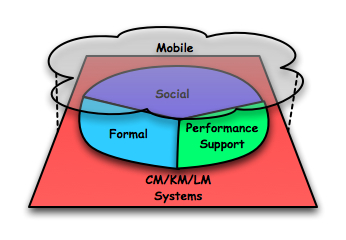 So I’ve been playing with rethinking my Performance Ecosystem conceptualization and visualization. The original had very discrete components, and an almost linear path, and that doesn’t quite convey the reality of how things are tied together. I believe it’s useful to help people see the components, but it doesn’t capture the goal of an integrated system.
So I’ve been playing with rethinking my Performance Ecosystem conceptualization and visualization. The original had very discrete components, and an almost linear path, and that doesn’t quite convey the reality of how things are tied together. I believe it’s useful to help people see the components, but it doesn’t capture the goal of an integrated system.
I’ve been wrestling with my diagramming application (OmniGraffle) to rethink it. My notion is that systems, e.g. content/knowledge management/learning management systems underpin the learnscape, and that on top exist formal learning, performance support like job aids organized into portals, and social media. Mobile is a layer that floats on top, making contextually accessible the capabilities assembled below. It’s not perfect, but it’s an evolving concept (perpetual beta, right/).
 So here’s my current conception. It took me a long time to create the circle with different components! First I had to discover that there were tools to create freeform shapes, and then work to get them to articulate, but I like the kind of ‘rough’ feel of it (appropriate for it’s stage).
So here’s my current conception. It took me a long time to create the circle with different components! First I had to discover that there were tools to create freeform shapes, and then work to get them to articulate, but I like the kind of ‘rough’ feel of it (appropriate for it’s stage).
It also captures the conceptual relationships as spatial relationships (my principle for diagram creation). At least for me. So here’s the question: does it make sense for you? Does it help you perceive what I’m talking about, or is it too a) coarse, b) confusing, or c) some other problem? I welcome your feedback!
Hey, Clark –
I see where you’re going with this:) Had a similar model around somewhere (much more cluttered than yours is).
The elements that seem a little out of alignment to me:
1. The whole thing is underpinned by formalized technology(and technology itself). I’m sad that e-solutions hang out together. I think the world is really much more organic than that. I think technology is important, but the whole thing shouldn’t fall apart if the rug of technology is pulled out from under it:) Maybe that layer could share an equal representation of underpinning that is ‘the real world and everything else’. This is defined by stuff like (1) Google, (2) Your local library, (3) That smart senior guy that you work with, (4) Your little sister’s genius friend, (5) a penchant for experimentation… or anything else that’s not a formalized CM/KM/LM. The real world deserves at least an equal share. If you want to stratify further, maybe there’s a part of that level’s sphere that is ‘social tools in the wild’.
2. I like performance support in the pie. I think that there’s more to formal and social than the diagram represents. There’s individual (which could be formal or informal – doesn’t have to be social), informal could overlap with performance support (how many of us search for what we need without ‘participating’ actively), and social could be peer / group or have a facilitated component that overlaps with formal.
I’m digging the mobile layer. I do think of this outside the normal sense of mobile (devices). This is ‘where you are’. Mode doesn’t matter. Low tech ‘where you are’s’ could include a printable that you could read on the train.
To me the forward strides are going to be dropping the fences and coming to terms with e-solutions as part of the natural order of everything. Sometimes that’s formally constructed for the learner, and other times it’s learner constructed or discovered. Options and not pidgeon-holing to a specific set is where it’s at, imo.
If 42 is the answer, what was the question? :P
Steve (do I have that right?), thanks for the detailed feedback. To be clear, my intention is that you may not have the KM/CMS/LMS underpinnings, it’s a goal, not a given. And you’re right, I hadn’t explicitly accounted for Google, library, etc, but I see them as components of informal (social/perf supp). I’m more concerned with the elements that organizations should be considering, rather than all the elements out there (they just shouldn’t block them ;).
And I worked very hard to have performance support/social integrated into a whole with formal, implying both an overlap and integration. I agree that dropping fences is critical: support people in getting information, not control it. Let’s set those pigeons free!
I gotcha ;) Maybe the model representation could look a bit less tech / IT centric?
I know that in reallity a lot of what we do is supported by IT:) I think it’s up to us to temper the focus and consider ‘nature and people’